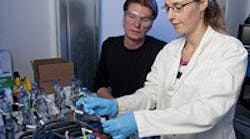Microbes, called methanogens, promise to provide an abundant source of methane, report researchers from Stanford University, Palo Alto, Calif., and Pennsylvania State University, University Park, Pa. The scientists hope to create large microbial factories that will transform electricity from clean energy into renewable methane fuel and other chemical compounds.
METHANE PRODUCERS
Figure 1. Post-doctoral fellow Svenja Lohner, right, and Professor Alfred Spormann, are members of a team working on producing gas from electricity. Source: L.A. Cicero/Stanford University."Understanding how this metabolic process works is the focus of our research. If we can engineer methanogens to produce methane at scale, it will be a game changer," says Alfred Spormann, a professor of chemical engineering and of civil and environmental engineering at Stanford. The team has been working since 2009 to develop a methanogen strain that could convert an electrical current directly into methane. They started by spreading a biofilm mixture of Methanobacterium palustre (M. palustre) and other microbial species onto the cathode of a reverse battery with positive and negative electrodes placed in nutrient-enriched water. When an electrical current ran through, the M. palustre churned out methane gas. The bacteria consume carbon dioxide and electrons borrowed from hydrogen gas. "The whole microbial process is carbon neutral," explains Spormann. "All of the CO2 released during combustion is derived from the atmosphere, and all of the electrical energy comes from renewables or nuclear power, which are also CO2-free."The team reports that the microbes are about 80% efficient in converting electricity to methane. However, thermodynamic efficiency is lower and more in the 60% range as typical for microbial metabolism, says Spormann.The rate remains high as long as the mixed microbial community is intact. When the team introduced other species to the mix, the rate plummeted."While conceptually simple, there are significant hurdles to overcome before electricity-to-methane technology can be deployed at a large scale," cautions Bruce Logan, a professor of civil and environmental engineering at Penn State. "That's because the underlying science of how these organisms convert electrons into chemical energy is poorly understood."First up in addressing these challenges, says Spormann, is to "optimize the microbe-electrode interaction." "This includes initially [developing] a better understanding of the science basis through basic molecular and genetic research. We also need to better understand the ecology in these electrode environments to design a stable process that can operate stably for longer periods of time," he adds.Current research focuses on the composition of different microbial communities and seeing how they evolve over time. This includes feeding electricity to mixed strains of archaea and bacteria that compete with methanogens for carbon dioxide, which the bacteria use to make acetate."There might be organisms that are perfect for making acetate or methane but haven't been identified yet," Spormann says. "We need to tap into the unknown, novel organisms that are out there."Spormann hopes within two to three years, the researchers will have a better understanding of the process and can begin to scale up the system. "Then, while scaling up, the ecological challenges typically associated with such upscaling need to be addressed through fundamental research," he notes.The team's ultimate goal is to create a cost-effective system. To this end, Spormann notes they'll be paying close attention to areas involving electrode material, the increase of electrode surface and biofouling.
